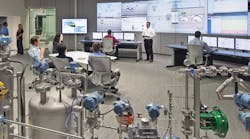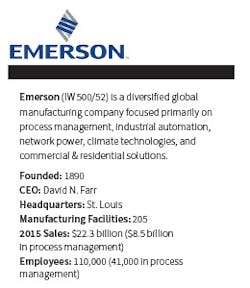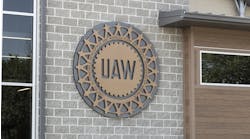In Emerson's Integrated Operations Center in Austin, Texas, Mike Boudreaux is leading a demonstration of the company’s new services to help customers – chemical plants, oil refineries and other process manufacturers – operate their plants more effectively.
Boudreaux, Emerson’s director, Performance and Reliability Monitoring, takes a visitor through the various software packages, communication protocols and analytics that can be put to use to ensure that control valves in a huge plant operate properly and that potential failures in those valves are detected before they lead to a spill or shutdown. At the conclusion of this technical tour de force, Boudreaux makes a surprising comment.
“The technology is exciting but that’s not the point,” he says. “The point is we need to help our customers improve the reliability and performance of their valves.”
You would be hard pressed to find reliability and availability generating as much excitement as collaborative robotics or 3-D printed cars do – unless you visited a processing plant. In a chemical plant or oil refinery, the number of hours that they can keep equipment operating and production flowing is critical. Increase the amount of time in operation and you increase sales and profit. And in any business, that is exciting news.
How Emerson is going to help those customers, however, is a vivid demonstration not just of understanding customers’ needs, but of how the Internet of Things is changing industrial companies, their products and their business models. Emerson is evolving into a provider of products and services where digitalization enhances not just the products it makes but the power of its human resources.
CEO David Farr touched on this transformation in his note to stockholders last year.
“True solutions are more than just a product in a specific application. Solutions allow our customers to leverage vast amounts of actionable data and innovative systems to fuel smart strategies and achieve Top Quartile Performance,” he wrote. “This is the Internet of Things, a space where Emerson has excelled for years. Solutions built on reliable data and combined with our extensive experience are more efficient, more effective and deliver exactly what customers need.”
Achieving the Tesla of IoT
For the oil business, one of Emerson’s biggest customers, efficiency has become the watchword of the industry as it struggles to make its oil and gas investments profitable.
“If you look at an offshore platform, they don’t want to drill more wells. They want to get more out of what they already have,” says Boudreaux. “The capital cost to invest in production wells is enormous. An 88% production availability platform versus a 93% production availability platform is a difference of $100 million of revenue in one year.”
For 40 years, process plants have relied on digital control systems to manufacture their products and to ensure the processes run safely. Sensors fed data on pressure, temperature, flow rates and other factors to control systems where the data was analyzed and then actions taken to keep processes within operating parameters or to shut down processes if they posed a danger.
That was the first generation of digital architecture, says Peter Zornio, chief strategic officer for Emerson, what he calls the “model T of IoT.” But now, he says, cheaper sensors, massive computing power and communication through the internet are combining to offer a new generation of systems that will not only control the plant but optimize its operations. That data can be available not just to plant operators on a local area network but through the internet to anyone in the world.
“We’ve gone from the Model T to the Tesla of architecture - still a car, but a very different kind of animal that what we started with,” says Zornio.
The key to taking advantage of the industrial internet of things, Zornio stresses, is to focus on the applications and the parts of your operations that you are trying to improve.
In the case of industrial valves, the problem is clear. A process facility can have hundreds of valves. The failure of even one critical valve can have devastating results. Companies try to prevent such failures by overhauling all their valves during a planned shutdown. This is not only expensive and results in a lot of unnecessary work, says Boudreaux, but can actually cause damage to some valves.
Moreover, even large facilities are thinly staffed. There may be only one valve expert at a plant and that person may be promoted, transferred or hired by a competing firm. Sustaining expertise at a facility often is not feasible, he points out.
In addition, valves can be located in remote locations that epitomize the definition of 4D – dull, distant, dirty and dangerous. Even in Houston, says Boudreaux, skilled professionals are “more interested in working in high-rise facilities than out in a plant.”
Find the Latest Internet-of-Things News, Trends and Best Practices
Given this gap between customer resources and what new technologies offer, Emerson is offering an increasing variety of services where it provides the expertise to monitor customers’ equipment and even, in some cases, a turnkey service where it installs its equipment and then monitors and maintains it. Those services may be offered through a set monthly service contract or on an outcomes basis where the customer and Emerson establish a goal and then Emerson is remunerated for its success in meeting that goal.
Certainly, the improving economics of sensor technology and computing are making new applications more attractive. In the past, Zornio notes, sensors had to be inserted in a pipe or vessel and then wired for power and communications. The cost of installation could range from 5X to 10X the cost of the sensor itself. But Emerson now offers a family of sensors that Zornio notes “are self-powered, easy to install and maintain and easy to get the data out of using wireless technology.”
This technology, which Emerson calls Pervasive Sensing, offers tangible differences in how plant equipment can be monitored, Zornio says. Today, he observes, you may have an employee walk around and measure vibration on a pump once a month. “You don't have real-time data. You have infrequent, manual data that a lot of times goes on a clipboard, in a stack of paper and doesn't get looked at again. With Pervasive Sensing, we are going to make it automated, real-time data that you can feed directly into a system and make use of it.”
But while cheaper sensors are helping introduce improved ways to manage plant operations, the biggest change for process industry customers, says Zornio, is that they no longer have to purchase the monitoring equipment and run it themselves. They now can purchase this function as a service from Emerson.
“As a customer, you don't just have to buy tools from us. You don't have to have guys in your own plant who can interpret that data and take action. You can just say, ‘Emerson, I need to lower my energy cost. Can you come in and put in the instrumentation you need, collect the data and feed that to your systems anywhere in the world so your experts can look at it and just tell me what I need to do when I need to do it?” Zornio explains. “It's a service.”
Security Concerns
While the Internet of Things offers companies new ways to improve the efficiency of their operations, it also presents them with unsettling questions about security. Traditionally, plant control systems have been closed to outsiders. While most businesses are concerned about hackers taking their information, many plants have been more concerned about what could be introduced into their systems.
Zornio said these facilities frequently have dangerous processes and are concerned about a hacker taking control of a valve, for example, and causing a toxic gas leak. Customers, he says, “want systems to be rock solid secure.”
Emerson offers a number of ways to keep data secure. For example, at one facility, Emerson is taking data from sensors and running it through a cell phone network that is completely separate from other systems at the plant. In other cases, the company offers secure data solutions so that it can access more data for a more holistic view of operating performance.
“What we like to say is that we are going to provide that secure first mile of data coming out of the plant,” says Zornio.
As might be expected, companies are not moving lockstep in how they are implementing these new technologies. Zornio speculates that the market will bifurcate, with large companies using their own integrated operations centers and holding onto their data. Smaller companies, he thinks, will end up purchasing services from Emerson or another company.
That process is likely to speed up, says Zornio, as younger managers take control of companies. They are more open, he believes, to purchasing services and likens the process to them using Uber rather than buying a car.
How is Emerson coping with the changes coming from the IIoT? Zornio says for now, the change is more step-by-step than disruptive.
“Because the customers are moving slowly, it doesn't feel like a revolution internally for us either. We are selling the IoT model aggressively. When they try it, they tend to stick with it,” he says, adding, “It is more of a push than a pull right now to get them to do that. It is still early adopters.”
Still, it presents challenges from keeping up with a wide range of evolving technologies to managing the financial end of new business models.
“All your financials as a manufacturing company are set up around inventory, cost of goods sold. It is about selling lawn mowers, not being a lawn service,” Zornio says. “Move over to other side, suddenly you're in a model where you might need to hold more capital because you are going to put equipment in a customer’s plant to monitor what is going on and you will retain that and that will be financed by an annuity contract.” And for customers, there are tax changes, for instance, where they don’t depreciate a capital asset at their facility because it is there as part of a service contract.
While technology is facilitating change in its business, Zornio emphasizes that it is Emerson’s domain knowledge that offers an essential competitive advantage.
“If a company decides they want somebody to monitor energy use, they are not going to trust just anyone that has a nice technology stack,” he says. “They want to go to the guy who knows what he’s doing with regard to energy management. Expertise in the application space is king.”






